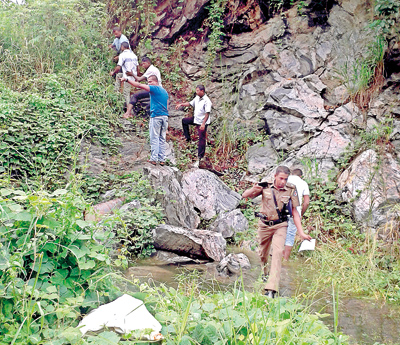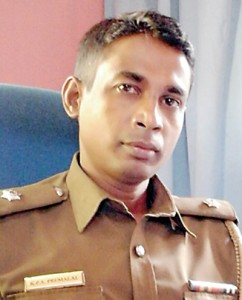News
Spate of crimes: What’s happening, ask people
A sudden rise in reports of child molestations, kidnappings and killings of children and women in the past two weeks and the brutality of the crimes, have created a fear psychosis among the people who doubt the law enforcement authorities ability to deal with the alarmingly increasing crime rate.
The rape and killing of four-year-old Seya from Kotadeniyawa, the brutal murder of a ten-year-boy in Athurugiriya and the killing of a 48-year- old woman, a tea plucker in Kahawatta, within the space of two weeks have jolted the people, into questioning what’s happening to our society.
The police, who however, compare the figures from previous years’ maintain that the crime rate has not increased although they acknowledge that the brutality of the crimes have intensified.
According to police figures for 2014, for every 100,000 Sri Lankans ‘only’ 220 cases of crime have been reported which in their opinion is comparatively low.
Last year, police media spokesman SSP Ajith Rohana compared the figures of grave crime for the year with statistics of ten years back and said technically the homicide rate had come down by 120 per cent.
He tallied homicide figures in 2004to 2014 and said, that the numbers have dropped considerably from 2,188 to 438 murders respectively.
Acting police Media Spokesman SSP Priyantha Jayakody last week claimed that there has not been an increase in the crime rate this year, but also expressed doubt about the accuracy of the figures as he said all crimes are not reported to police.
He however accepted that the brutality of the crimes was worse in recent times and this was impacting on the fear psychosis of the people.
He said the police were not solely to be blamed for the brutality of crimes and stressed on the importance of all institutions concerned with maintaining law and order and the civil society at large joining hands in combating crime. “This is the responsibility of all,” he said.
The spokesperson said in the case of little Seya the family failed to give protection to her. The mother was not aware that the child had been carried away in the middle of the night and they assumed she was in the house sleeping with the grandparents.
It was the same he said when it came to the revenge killing of the 10 year old boy in Athurugiriya whose body was dismembered and strewn in a house. It was a planned murder and the suspect had seven criminal offenses against him. He had planned the murder six weeks earlier and had even bought a knife one month ahead. In both cases the children were left unattended, he said.
This highlights the need to identify people who visit homes or come to live with families, he said. He alerted householders to be vigilant and wary when taking domestic helpers and strangers into homes by checking their identities with the police.
“Parents have to be careful of their children. It is important to identify those whom you associate with. Criminals know how to get away with crime,” he warned.
Another contributory factor he said was the prisons. “Whether the inmates undergo a proper rehabilitation process, is questionable,” he noted.
SSP Jayakody stressed the need to have prisoners sufficiently rehabilitated before being sent out into society again. He said it was also important to see that mentally disturbed inmates underwent proper psychiatric treatment before being sent back to society.
SSP Jayakody also conceded that the delays in the legal system contributed to the escalating crime rate. According to police there is a backlog of an average of of 35,000 cases each year. Of the 50,962 cases in 2014, 34,461 were still pending while in 2013 out of 55,349 cases 37,512 were pending in court.
However, the Bar Association of Sri Lanka (BASL) Secretary, Ajith Pathirana refutes the charge that the courts were to be blamed for the laws delay. He threw the ball into the police court saying that the judges were ready but the police delayed the investigations.
He said procedural methods that involved the analysis of finger prints, evidence, seeking expert opinion and finding witnesses also took time.“In the case of rape and murder the time taken is even longer as it has to be sent to the Attorney General,” he said.
Cases also drag on when defendants seek redress in the Appellate Courts, Mr.Pathirana said, stressing the need to regularise the investigative system and provide the police with the necessary expertise to expedite the process. “They should be given the required machinery and equipment. Most importantly a time limit has to be set for completing investigations,” he said.
Responding to the popular notion that suspects released on bail could return to crime with impunity, he maintained that this does not happen as suspects are not habitual criminals.
“They are presumed innocent unless proven guilty and the courts in keeping with the Sri Lankan Constitution section 12 (2) have to grant freedom to all, unless proved guilty,” he said.
In addition, he said, the court is discreet when granting bail and only after a careful consideration of the suspect’s background and previous history is bail granted.
He said society as a whole has to combat the rise in crime. Religious institutions, schools, parents, and elders, should join in this endeavour, he said.
Meanwhile Prisons’ Chief Rohana Pushpakumara denied allegations that the rehabilitation process was insuffient. He said the department had effective rehabilitation programmes to reform prisoners.
He also countered the argument that those sentenced for minor offences were kept together with hardcore criminals which resulted in minor offenders returning to graver crimes when they were released.
He said there was no truth in this allegation as they were kept in separate cells. “This is the general belief. This does not happen,” he said. However he admitted that in the remand prison this may occur.
He further refuted the charge that prisons were overcrowded and said that in reality there weren’t enough convicted prisoners to engage in agricultural programmes that are conducted in open prisons of Weerawila, Pallekele, Watereka and Anuradhapura.
Sabaragamuwa University’s Senior lecturer, Department of Social Sciences, M.N. Jayatunga who has done extensive research on the crime rate in Sri Lanka said the brutality of the crimes could be attributed to the advent of information technology and modern hi-tech equipment with easy access to porn sites.
She said these sites and blue films have an impact on sex starved psychopaths. Many who commit brutal crimes were psychopaths, paedophiles and perverts who are driven to experiment their abnormal sexual inclinations on vulnerable people.
Ms. Jayatunga stressed the importance of sex education in schools to protect the children.
| Jobless, homeless hobo avenges eviction by killing landlord’s son aged 10 It was a revenge killing planned for more than three months that took the life of a 10-year-old schoolboy from Kapurugama, Athurugriya last week.  The area where the suspect was hiding. Pic by Anuradha Bandara A man identified as Abraham Perera had obtained employment at a quarry in Athurugiriya, owned by the child’s uncle, one-and-a-half-years back. However, a few months later the license for the quarry lapsed and was shut down, but the suspect had stayed on in a temporary room built for the workers. The 10-year-old child’s father repeatedly reminded the man to vacate the premises as the quarry was non-operational.  Sub Inspector Asanka Premalal According to police investigations, Perera had wanted to take revenge on the child’s father, but decided to harm one of the family members, as it would be more painful for the person on whom he wanted to take revenge. Three months earlier, the suspect had bought the knife for Rs 1,000 from a blacksmith. As the child was close to the suspect, he was a regular visitor to the suspect’s ‘quarters’. “On the day of the incident, when the child came to the suspect’s room, he had had told the boy there were coins buried in the room and he could take them. As the boy was looking for the coins the man had hacked him with the knife and killed him,” police said. The man fled after the murder leaving no trace, as his identity was not known. “The only thing known about him was that he usually wore a white sarong and shirt, was minus a finger and used dentures. Nobody knew from where he was,” Sub Inspector Asanka Premalal, OIC Crimes Division, Athurugiriya police, told the Sunday Times. “An informant told us he had been spotted in the Kaduwela area, which proved to be incorrect. A second informant said the man was seen near the Kaduwela bridge, which proved to be correct. Within 24 hours of the murder the suspect was arrested and the murder weapon also recovered,” he said. The man had been earlier charged for murder, but the case had not been proved due to lack of evidence ,while there were several cases against him for housebreaking. The suspect was produced before the Homagama Magistrate Y.R.D. Nelumdeniya and remanded till October 7. |

